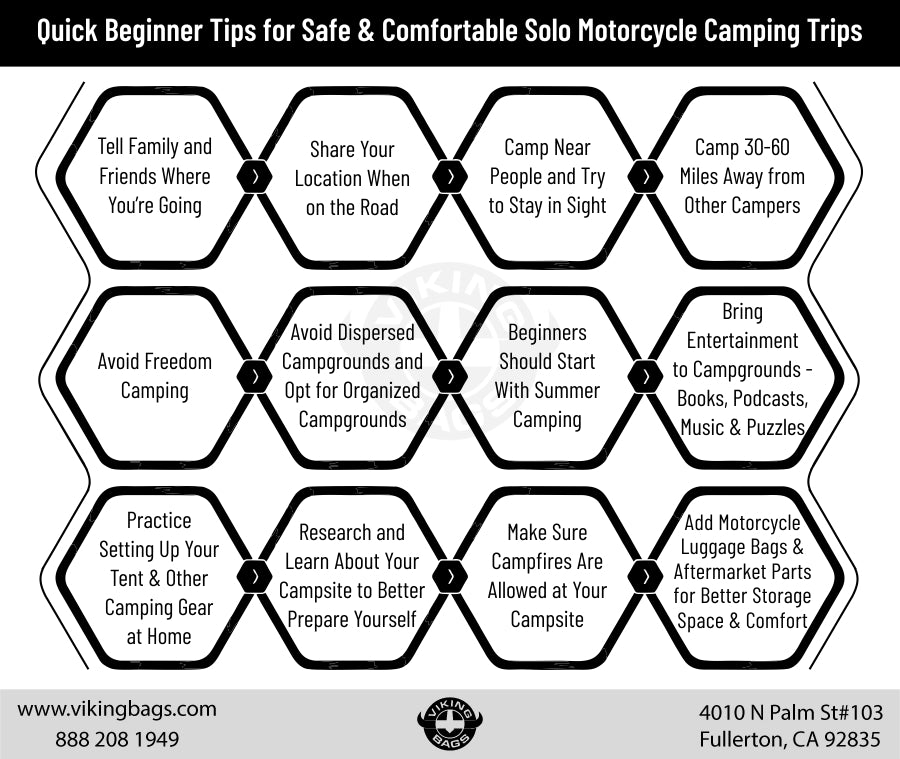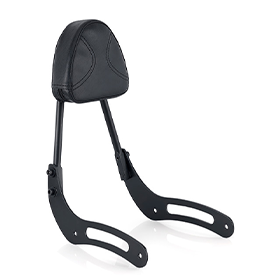Going on your first motorcycle camping trip can be exciting but scary, especially when riding solo. Many riders become discouraged from going on a solo motorcycle camping trip because they are uncomfortable traveling to a deserted campsite hundreds of miles away from home.
This article provides tips on how to embark on your first solo motorcycle camping trip.
Also Read: Motorcycle Camping Guide - How to Camp Everywhere?
- Table of Contents
- 1. Beginner Tips for Your First Solo Motorcycle Camping Trip
- 1.1 Equip Your Motorcycle for Motorcycle Camping
- 1.2 Plan Short Camping Trips
- 1.3 Tell Your Family & Friends Where You’re Going
- 1.4 Stay in Sight
- 1.5 Reserve a Campsite at Organized Campgrounds
- 1.6 Camping During Summer
- 1.7 Plan Activities
- 1.8 Practice Setting Up Camping Gear at Home
- 1.9 Know Your Campsite & Any Potential Hazards
- 1.10 Avoid Campgrounds with Campfire Restrictions
- 1.11 Ride a Suitable Motorcycle
- 2. Takeaway
1. Beginner Tips for Your First Solo Motorcycle Camping Trip
When planning your first solo motorcycle camping trip, you need to ensure safety and comfort. Your first motocamping trip should not involve riding over 600+ miles to reach an off-the-grid motorcycle campground for the following reasons:
- Being off-the-grid makes it hard for people to find you or come to help you.
- Dispersed campgrounds lack amenities and camping in harsh conditions is hard without adequate motocamping experience.
- Remote motorcycle campgrounds don’t have many visitors, meaning there are fewer opportunities to interact with other motorcyclists.
1.1 Equip Your Motorcycle for Motorcycle Camping
Adventure touring motorcycles are ideal two-wheelers for motorcycle camping as they can cover hundreds of miles on long highways, tackle off-road trails, and have adequate storage space to carry your camping gear. But if you don’t have an adventure tourer, equip your motorcycle with sissy bars, saddlebags, sissy bar bags, motorcycle backpacks, luggage racks, and other motorcycle luggage and aftermarket parts to provide adequate storage and comfort.
Also Read: How to Pack for Motorcycle Camping
1.2 Plan Short Camping Trips
For your first motorcycle camping trips, visit the campgrounds closest to your city or state. Short weekend camping excursions help you get used to motorcycle camping. Starting by camping in areas close to your place of residence will help you feel safe, confident, and comfortable due to the familiar surroundings.
Plus, traveling to a nearby campground means you will likely not suffer fatigue and have more energy to find a campsite with access to facilities and scenic views. You can also easily cover short distances on a standard motorcycle if you don’t own an adventure tourer, a cruiser, or a bagger motorcycle.
1.3 Tell Your Family & Friends Where You’re Going
Most motocampers go on motorcycle camping trips to get away from work, responsibilities, and stress. But before you embark, make sure to tell your family and friends where you’re going, the route you plan to take, and how long you plan to go motorcycle camping.
When on the road, share your location with family or friends using your phone. If you find yourself stranded or injured, your family or friends will know where to find you.
Knowing that someone is aware of your whereabouts and can be depended on to send assistance will help put your mind at ease.
1.4 Stay in Sight
Many motorcycle campers look for remote campgrounds to ensure peace and solitude. However, it is best to stay near other people. Knowing other people are around will help you feel less anxious when camping alone.
For seclusion, pitch your tent about 40-60 miles from the crowds. This will reduce the noise of chatter, laughter, and RV generators that could disturb your sleep while keeping you within view of others.
Being near crowds will reduce the likelihood of animal attacks. Moreover, people nearby can help you if you are having trouble setting up your camping gear, starting your motorcycle, or starting a campfire.
1.5 Reserve a Campsite at Organized Campgrounds
As a beginner, do not stay at dispersed BLM campgrounds and non-reserved FCFS motorcycle campsites. Instead, reserve a campsite at an organized motorcycle campground. At organized campgrounds, there is less risk of your motorcycle or motorcycle parts being stolen.
Also Read: Ways to Keep Your Motorcycle Sissy Bars from Being Stolen
Organized motorcycle campsites tend to be located near towns and villages with supermarkets, bakeries, diners, gas stations, ATMs, and motorcycle repair shops. Organized campsites also have amenities, including clean water, washrooms, firepits, electricity, hot showers, restaurants, and laundry machines. The facilities available at or near camping destinations make it so you do not need to pack a lot of luggage.
Organized campsites at national parks have well-paved tarmac roads, smooth gravel paths, well-maintained parking areas, and designated campgrounds.
Also Read: How to Find the Best Motorcycle Campgrounds?
1.6 Camping During Summer
The best time for beginners to go on motorcycle camping trips is during the peak summer months. You will have to reserve a campsite at least 3-6 months in advance.
In summer, weather conditions are more predictable, with less chance of rain. There are also more hours of daylight, meaning you have more time to set up your tent and camping gear. Summer camping gear is lightweight and can be easily carried with plenty of storage space left.
1.7 Plan Activities
At the campsite, you can engage in plenty of recreational activities, such as hiking, motorcycle rides on scenic routes, water sports, and observing wildlife.
When resting at your campsite, you can read a book, record your experiences in a journal, listen to podcasts and music, or enjoy a cup of coffee by the campfire. Activities will held reduce boredom, fear, and apprehension, especially in the evening.
1.8 Practice Setting Up Camping Gear at Home
Setting up motorcycle camping gear for the first time can be tricky and time-consuming. Before you go on a camping trip, familiarize yourself with your motorcycle camping gear. Learn how to set up your motorcycle camping tent or hammock, arrange your motorcycle camping gear, place your sleeping bag and pad, etc.
Also Read: Best Motorcycle Camping Setup
1.9 Know Your Campsite & Any Potential Hazards
It is best to reserve a spot at an established campsite for your first solo motorcycle camping trip. You can research information, pictures, and reviews about reservation-only campsites.
The more you know about the campsite, the better you will be prepared for potential hazards. For example, if you know that your campsite often has grizzly bears, you can pack bear spray and learn all the necessary precautions.
1.10 Avoid Campgrounds with Campfire Restrictions
In summer, campfires are restricted in organized campgrounds, BLM areas, national parks, dispersed national forest campgrounds, and private campgrounds.
Before you reserve a spot at a campsite, check for campfire restrictions to avoid areas where campfires are not allowed. Campfires help you feel comfortable, keep wild animals away, offer a sense of security, and help you relax when listening to music or podcasts.
1.11 Ride a Suitable Motorcycle
When traveling to a campsite, you will have to navigate sharp turns and difficult terrain. It is important to ride a motorcycle that can handle rough terrain or you risk damaging the suspensions, engine, and tires.
To determine whether your motorcycle is suited for traveling over different terrains, plan a test camping trip to evaluate your motorcycle’s performance. If your motorcycle cannot handle rough terrain, rent a budget-friendly adventure tourer or off-road motorcycle from an online motorcycle sharing platform or motorcycle rental service.
Also Read: Top 10 Adventure Motorcycle for Freedom Motocamping

2. Takeaway
Motorcycle camping is an enjoyable recreational activity but can be scary for beginners. When seeking adventure, it is important to keep comfort and safety in mind.
As you become more familiar with motorcycle camping, including the potential challenges and negative aspects, you can start to try other camping styles, including wilderness motorcycle camping in remote areas and dispersed/freedom motorcycle camping without facilities. As you go on more motorcycle camping, you will become more confident camping by yourself.
Also Read: What to Take on a Motorcycle Camping Trip - A Thorough Motocamping Checklist

















Leave a comment
All comments are moderated before being published.
This site is protected by reCAPTCHA and the Google Privacy Policy and Terms of Service apply.